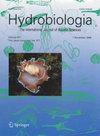Physical functionality as an indicator of habitat availability in Islas Marietas, Nayarit, Mexico
IF 0.3
4区 生物学
Q4 MARINE & FRESHWATER BIOLOGY
引用次数: 0
Abstract
Background. Few investigations use functional diversity and the reef functional index (IFA) to assess the sta-te of reef communities. Objectives. Evaluate physical functionality as an indicator of fish habitat availability and its relationship with functional diversity. Methods. The physical functionality of the reef was evaluated using the IFA, integrating data on coral cover, structural complexity, and calcification rate. The structure of the fish assemblages was analyzed by calculating functional diversity indices (richness, evenness, and divergen-ce) based on six functional traits (body size, mobility, activity period, type of aggregation, position in the water column, and diet). The relationship between functional diversity and IFA was evaluated using linear regression analysis. Results. Área de Restauración showed the highest values in the IFA; on the contrary, Túnel Amarra-dero presented the lowest values. In both sites, a greater presence of Pocillopora verrucosa was observed. Functional diversity presented the lowest values in the three functional indices in Área de Restauración. Linear regression analyses were not significant. Conclusions. No linear relationship was found between the IFA and functional diversity; this can be attributed to the fact that in sites with low coral cover, such as Islas Marietas, the functional diversity of fish presents a weak relationship with the three-dimensionality provided by corals since in sites with low coral cover, other structural elements (geologic features and rock substrates) could promote these three-dimensional structures.物理功能作为墨西哥纳亚里特马里埃塔斯岛栖息地可用性的指标
背景。利用功能多样性和珊瑚礁功能指数(IFA)来评价珊瑚礁群落状况的研究很少。目标。评价作为鱼类栖息地可用性指标的物理功能及其与功能多样性的关系。方法。利用IFA综合了珊瑚覆盖、结构复杂性和钙化率等数据,对珊瑚礁的物理功能进行了评估。基于6个功能特征(体型、流动性、活动期、聚集类型、在水体中的位置和食性),通过计算功能多样性指数(丰富度、均匀度和发散度)对鱼类群落结构进行分析。采用线性回归分析评价功能多样性与IFA之间的关系。结果。在IFA中,Área de Restauración值最高;相反,Túnel Amarra-dero的值最低。在这两个部位,观察到更多的疣状棘孢的存在。功能多样性在Área de Restauración的3个功能指标中值最低。线性回归分析无显著性。结论。IFA与功能多样性之间无线性关系;这可归因于以下事实:在珊瑚覆盖较少的地点,如玛丽埃塔斯岛,鱼类的功能多样性与珊瑚提供的三维结构之间的关系较弱,因为在珊瑚覆盖较少的地点,其他结构因素(地质特征和岩石基质)可以促进这些三维结构。
本文章由计算机程序翻译,如有差异,请以英文原文为准。
求助全文
约1分钟内获得全文
求助全文
来源期刊

Hidrobiologica
生物-海洋与淡水生物学
CiteScore
0.40
自引率
0.00%
发文量
8
审稿时长
>12 weeks
期刊介绍:
HIDROBIOLÓGICA es una publicación cuatrimestral que difunde trabajos originales e inéditos de investigación o revisión, sobre temas relacionados con los organismos y la hidrología de los ambientes acuáticos, dulces y marinos y va dirigida a investigadores de todo el mundo, interesados en las diversas disciplinas que incluye la Hidrobiología , así como a alumnos de posgrados y licenciaturas relacionados con la biología, ecología, taxonomía, filogenia y evolución de organismos acuáticos, e hidrología y oceanografía de ambientes s dulceacuícolas y marinos.
 求助内容:
求助内容: 应助结果提醒方式:
应助结果提醒方式:


